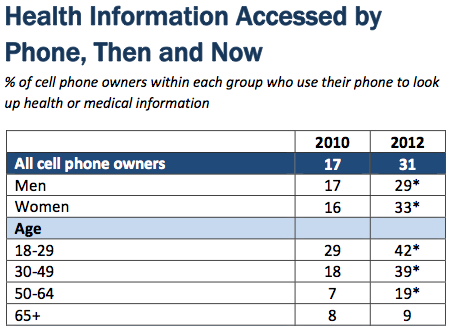
Source: Pew Internet/CHCF Health Surveys: August 9 ‐ September 13, 2010 , N=3,001 adults; August 7 ‐ September 6, 2012, N=3,014 adults ages 18+. Margin of error for both surveys is +/‐ 3 percentage points for results based on cell phone owners.
About 11 percent of all mobile phone users and 19 percent of smartphone users have at least one health app on their device, according to Pew Internet & American Life Project's Mobile Health 2012 survey, which the group published this morning. The percentage of mobile phone users who have downloaded a health app has remained unchanged since 2010.
Forty-five percent of the 3,014 adults surveyed said they used a smartphone. Pew's Associate Director Susannah Fox, who wrote the report, likened this smartphone tipping point to the adoption of broadband Internet back in 2003. In both cases, adoption happened quickly and fundamentally changed the way users engaged with the online world.
"Mobile seems to increase people’s likelihood to participate," Fox told MobiHealthNews. "It’s the smartphone owners that I ended up really focusing on in the analysis, because they’re so much more likely to use [their devices] to access health information."
This is the first year that Pew has identified smartphone users with a single question, rather than a complicated series. The term "smartphone" has only recently become widely understood enough for that approach to return meaningful results, Fox said.
The study looked at who was most likely to use health apps within the group of smartphone users. While 19 percent of smartphone users have health apps, that number changes to 22 percent for caregivers, 21 percent for those with chronic conditions, and 22 percent for those who had faced significant medical crises in the last 12 months.
Pew also asked about positive health events. Specifically, one question referred to "significant change ... such as gaining or losing a lot of weight, becoming pregnant, or quitting smoking." A full 29 percent of respondents who reported that kind of change were health app adopters.
Of the 254 health app-users in the survey, fitness and wellness apps dominated among respondents. Thirty-eight percent used apps to track exercise, fitness, or heart rate, 31 percent tracked diet or food and 12 percent tracked weight. The next largest categories were menstrual cycle trackers at 7 percent and blood pressure trackers at 5 percent. Fox said it was no surprise that the top three categories were wellness-related.
"But that's where the fun really starts," she said. "After the obvious findings."
The report lists a number of other health app categories cited by less than 1 percent of respondents, including "Hypnosis" and "First Aid." Fox said the "Long Tail" of the app market likely contains niche markets that could be successful for app-makers, but she did not specifically point to any of these niche categories as winning ones.
Predictably, app adoption broke down along age lines, with 24 percent of health app users between ages 18 and 29 and another 19 percent between 30 and 49. Fox said the middle age group's interest in health is typical - that's the group that has their own personal health issues, as well as often caring for their children and parents. By 65 most people are seeing a doctor regularly and are happy with their offline care.
Fox says that data shows the youngest group, digital natives, are more intimate with their smartphones, and therefore they might be more comfortable casually corresponding with them on health-related questions. Because these young adopters see the smartphone as a go-to for all information, that includes health information also.
Outside of apps specifically, the survey showed that 31 percent of mobile phone owners have used their phones to look up health information, up from 17 percent in a comparable 2010 survey. When you look at just smartphone owners, that number goes up to 52 percent. The report showed that Latinos, African Americans, those between the ages of 18 to 49, and those with college degrees are more likely than others to use their phones to look for health information.
The increased health engagement of Latino and African American users can be partly explained by the diversification of the country, Fox said. Younger people are statistically more likely to be minorities than older people are. Additionally, though, there is a perception that Latinos and African Americans are more likely to be mobile-only and early smartphone adopters.
Only 9 percent of the 2,581 mobile phone users surveyed used text messaging to receive health or medical information, with women, African Americans, and those between the ages of 30 and 49 the most likely to receive health information by text.
















